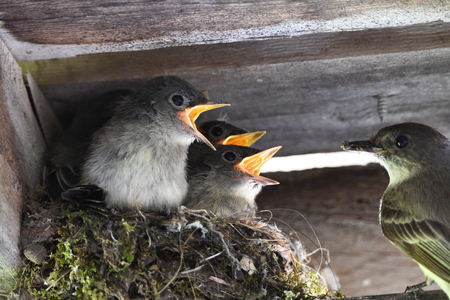
Good Natured: Eastern Phoebes
Last month the St. Charles Park District was honored to host a gathering at Norris Woods, our Illinois Nature Preserve located just north of downtown, on the east side of the Fox River.
It's a lovely parcel—it has to be, to earn that special preservation status. Permanently protected by state law, IL Nature Preserves are lands that have rare plants, animals, or other unique natural features. Its official description describes Norris Woods as “a remnant of the original dry-mesic upland forests that once bordered the Fox River [which] contains about 10% of the most outstanding natural forest remaining in the Morainal Section of the Northeastern Morainal Natural Division."
In other words, it's a really cool place.
Back on that April Saturday, we were celebrating Norris Woods' induction into the Old Growth Forest Network, a national organization that recognizes and promotes the importance of mature woodlands. After the speeches, the applause and the requisite photo opps, the attendees broke up into two groups. One, led by restoration ecologist Ryan Solomon, headed out to admire the tremendous diversity of plants that grow amid Norris's glacier-borne terrain. The other folks, God love 'em, stayed with me.
The focus of our walk was to be birds—a nod to the spring migration just getting underway, as well as St. Charles' new status as a member of Bird City Illinois. (Big thank you to the Audubon Council of Illinois, as well as local resident Suzi Myers for achieving this designation!)
As we wended our way along Eleanor's Path, a curvy route that leads to Norris's main trail, I felt marginally confident that we would see at least a few of the feathered friends we've come to associate with those woods: the blue jays that are drawn in by the abundance of oaks; the woodpeckers and chickadees that excavate their homes in those trees; perhaps some kinglets or a brown creeper and—with any luck at all—the two bald eagles that had graced Ryan and I with their presence the day before.
Now, I could fill up the rest of the page with excuses of how or why we didn't really see any of these species, as well as the details on what we did see, like the remains of a meal left trailside by a great horned owl. But instead, let's cut to the chase: Ryan's group—the plant people--got to see the bald eagles, and our group—the birders—did not.
That could be the end of the story but, given that the day was bright and sunny and reasonably warm, a handful of people chose to stick around once the walk was over. And that's when we heard it.
“FEE-be! Fee-BEE!"
Could it be?? Sure enough. Perched maybe 15 feet away, serenading us with its namesake song, was a perennial crowd pleaser…an eastern phoebe!
Although not the most colorful of the spring bird species, eastern phoebes seem to have a natural ability to make people happy. For one thing, they're migrants that return fairly early to breed right here in northern Illinois. Their appearance is a signal spring will soon be in full swing.
Second, phoebes are members of the Tyrannidae, or tyrant flycatcher family, which means they eat flying insects. Here in our little river town, if there's one thing we have a lot of, it's insects that fly.
Third, they're one of only a handful of Tyrannidae that can be identified with 100% certainty, even by mediocre birders like me. Though predominantly gray, like most flycatchers, and fairly small—another family trait—phoebes grant us one unmistakable mannerism: They dip their tails.
Eastern wood-pewees don't do this. Nor do least flycatchers, or in fact any of the other flycatchers that make their way through our area. Though each has its own field marks or sounds that aid in identification, only the phoebe carries on to the extent of being indisputably recognizable.
As if aware of my dubious skills, our Norris phoebe went all out to ensure the remaining part of our group saw and heard it, and could identify it beyond a shadow of a doubt. “FEE-be! Fee-BE!" Dip dip. “Fee-BE! FEE-b-be!" Dip dip dip.
(Tip: Another common bird in our area, the black-capped chickadee, also sings a “fee-bee" song. But in contrast to the hoarse-sounding phoebe, the chickadee's song is a two-toned, high-pitched whistle.)
Phoebes, bless their little hearts, give us one other distinctive habit. Their nests, usually in a sheltered location, are built of mud and moss. Chickadees, by contrast, use moss but no mud, and nest in cavities; barn swallows, another species that prefers to nest in sheltered spaces, use mud but no moss.
With spring migration now winding down, our summer resident birds are briskly going about their business of raising their families. You don't have to travel to Norris Woods to see and hear them in all their glory. Wherever you might be, keep an eye and an ear out for that little fan favorite, the eastern phoebe.
“FEE-be! Fee-BE!" Whee!
Pam Otto is the outreach ambassador for the St. Charles Park District. She can be reached at potto@stcparks.org.

